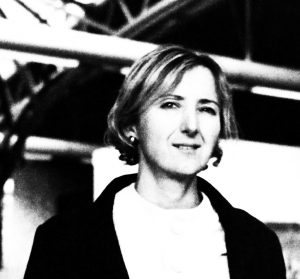We are proud to announce a curator of 11th Kaunas Biennial – Paulina Pukyte. Biennial will be held between 15 September and 30 November 2017.
Paulina Pukyte is an artist, writer, essayist, and cultural commentator. She lives and works in London and Vilnius. She holds a postgrad from the Vilnius Academy of Art, and a Master’s degree from the Royal College of Art in London. In 2001- 2003 and 2006 she was a guest lecturer at the Vilnius Academy of Art Kaunas Art Institute. She writes for the cultural weekly 7 meno dienos (7 Days of Art), and contributes to other publications in Lithuania; she has received Lithuanian Ministry of Culture award for her articles. She has published a collection of essays Netikras zuikis (Fake Rabbit), two fiction books: Jų papročiai (Their Habits), and Bedalis ir labdarys (A Loser And A Do-gooder), and a play Žuvies akys (Fish Eyes). A theatre production of Bedalis ir labdarys premiered at the Vilnius Small Theatre in November 2015. Extracts from this tragicomic book of dialogues and monologues are included in the anthology of Best European Fiction 2016, published by Dalkey Archive Press. In her visual art practice Paulina Pukyte uses site-specific installations, moving image, and found artefacts, twisting familiar meanings, subverting stereotypes, and questioning accustomed truths, always remaining in artistic opposition to the dominant or institutional discourse.
Curatorial Concept
THERE AND NOT THERE
questioning the possibility of a monument
When Lithuania broke free from the rule of the Soviet Union a quarter of the century ago, it quickly got rid of all the monuments and sculptures that had anything to do with the communist ideology or Soviet occupation. Then, with the same hastiness, we rebuilt most of the national monuments that the Soviets had destroyed, and erected some new ones, yet of the same pre-WWII style and content. After paying that debt to the past we could hope for new public art to become more contemporary, new monuments to be more suggestive, and the remaining ideologically controversial or dated ones to be re-contextualised and acquire new meanings. However, apart from the several successful but temporary public art projects, a few abstract sculptures (hated by the general public) and a couple of less traditional monuments, this didn’t catch on. In fact, we are experiencing regression – in recent years the few remaining specimens of Soviet sculptural heritage were removed (arguably the last example of Social Realism in Lithuania has succumbed to populist political manipulations), and there is also a rising urge to erect more bronze heroes that the new generation can hardly relate to. Even abstraction in monument projects is often regarded as insulting, and there are demands to memorialise freedom by directly repeating not only romantic, but also totalitarian tradition. And here, in Kaunas, in the totalitarian meat-grinder of the middle of the 20th century, my grandfather as a young man, together with 34,000 other Jews (a quarter of all pre-war Kaunas population), vanished without a trace. I found his telephone number in an old directory. 25367. From this moment it is the Zahir. But what about the others? When you walk around Kaunas, nothing reminds you that they all lived here, that they were all murdered, and why. But how to remember what is NOT THERE? How not to forget what is THERE? How to memorialise something you wish not to have been? And, in the face of over-saturation, what monuments do we really need?
Counter-monument is the monument against itself, against the traditional didactic function of monuments, against their demagogical rigidity and their authoritarian propensity to reduce viewers to passive spectators. (James E. Young)
The 11th Kaunas Biennial seeks to oppose monopolistically populist practice of removing-erecting and conservative traditionalism, prevalent in the memory discourse of public art in Lithuania, and to stimulate and legitimise radically new, contemporary, conceptual, relevant ideas and strategies for remembrance, inviting international and local artists to
– look back at the removed
– rethink the existing
– imagine the future monuments.


